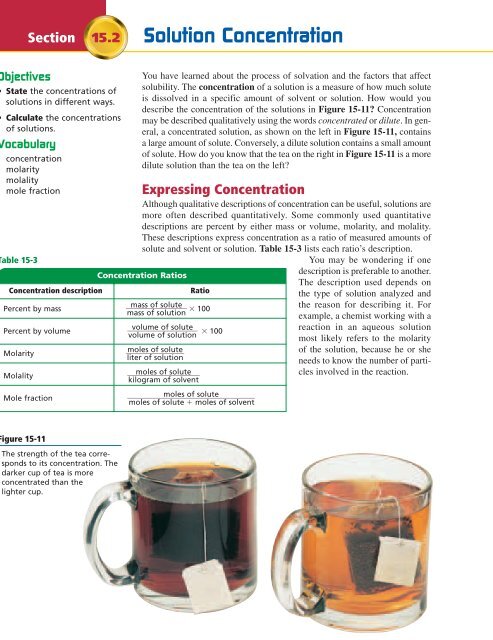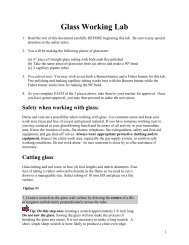Chapter 15: Solutions - Weironline.net
Chapter 15: Solutions - Weironline.net
Chapter 15: Solutions - Weironline.net
Create successful ePaper yourself
Turn your PDF publications into a flip-book with our unique Google optimized e-Paper software.
Objectives<br />
Section <strong>15</strong>.2 Solution Concentration<br />
• State the concentrations of<br />
solutions in different ways.<br />
• Calculate the concentrations<br />
of solutions.<br />
Vocabulary<br />
concentration<br />
molarity<br />
molality<br />
mole fraction<br />
Table <strong>15</strong>-3<br />
Figure <strong>15</strong>-11<br />
The strength of the tea corresponds<br />
to its concentration. The<br />
darker cup of tea is more<br />
concentrated than the<br />
lighter cup.<br />
462 <strong>Chapter</strong> <strong>15</strong> <strong>Solutions</strong><br />
You have learned about the process of solvation and the factors that affect<br />
solubility. The concentration of a solution is a measure of how much solute<br />
is dissolved in a specific amount of solvent or solution. How would you<br />
describe the concentration of the solutions in Figure <strong>15</strong>-11? Concentration<br />
may be described qualitatively using the words concentrated or dilute. In general,<br />
a concentrated solution, as shown on the left in Figure <strong>15</strong>-11, contains<br />
a large amount of solute. Conversely, a dilute solution contains a small amount<br />
of solute. How do you know that the tea on the right in Figure <strong>15</strong>-11 is a more<br />
dilute solution than the tea on the left?<br />
Expressing Concentration<br />
Although qualitative descriptions of concentration can be useful, solutions are<br />
more often described quantitatively. Some commonly used quantitative<br />
descriptions are percent by either mass or volume, molarity, and molality.<br />
These descriptions express concentration as a ratio of measured amounts of<br />
solute and solvent or solution. Table <strong>15</strong>-3 lists each ratio’s description.<br />
You may be wondering if one<br />
Concentration Ratios<br />
Concentration description Ratio<br />
Percent by mass �<br />
mass<br />
of<br />
�<br />
solute<br />
� 100<br />
mass<br />
of<br />
solution<br />
volume of solute<br />
Percent by volume ��� � 100<br />
volume of solution<br />
Molarity �<br />
moles<br />
o<br />
�<br />
f solute<br />
liter<br />
of<br />
solution<br />
Molality<br />
Mole fraction<br />
moles of solute<br />
���<br />
kilogram of solvent<br />
�����<br />
moles of solute<br />
moles of solute � moles of solvent<br />
description is preferable to another.<br />
The description used depends on<br />
the type of solution analyzed and<br />
the reason for describing it. For<br />
example, a chemist working with a<br />
reaction in an aqueous solution<br />
most likely refers to the molarity<br />
of the solution, because he or she<br />
needs to know the number of particles<br />
involved in the reaction.




